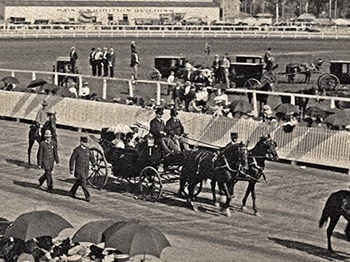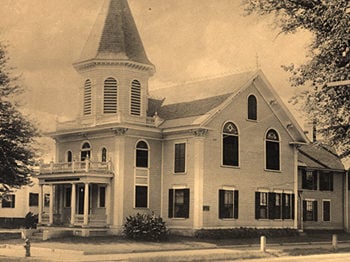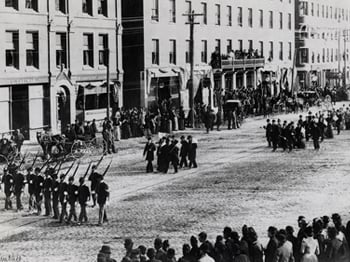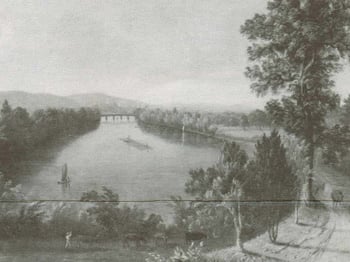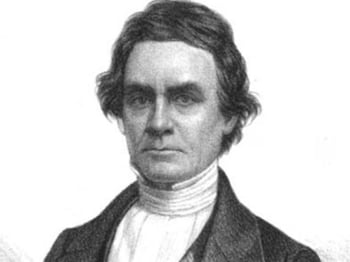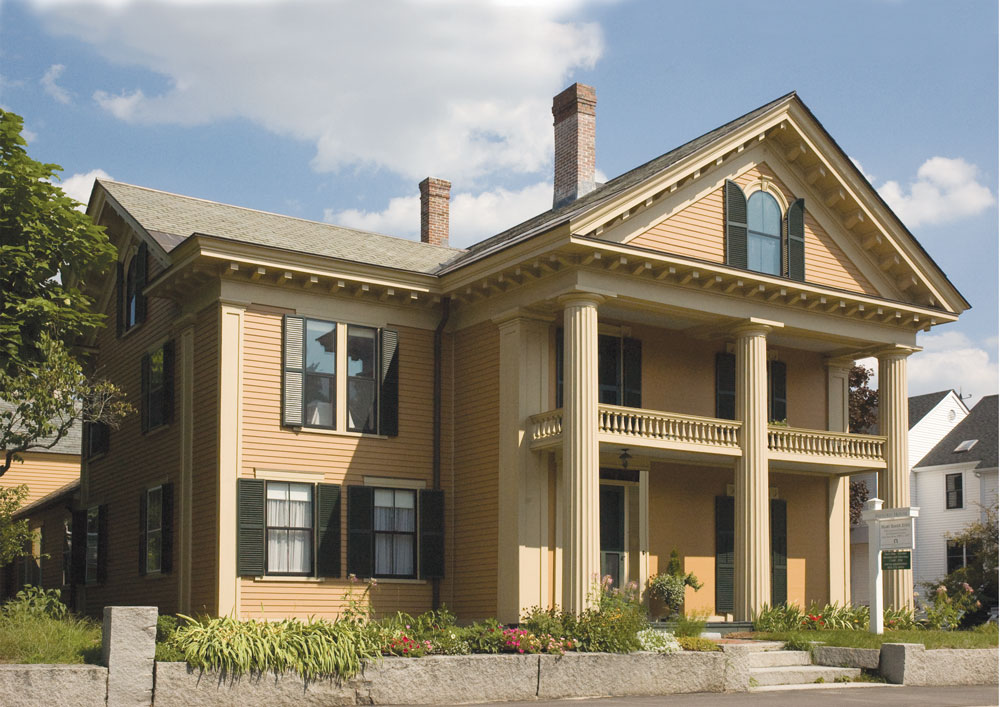
One hundred years ago, in June 1889, Mary Baker Eddy moved her household from 385 Commonwealth Avenue in Boston to 62 North State Street, Concord, New Hampshire. Her three years’ residence in the latter home would mark a fresh start for her church, as she swept away the old organization and made room for the new. Relieved somewhat of the responsibility to see to the day-to-day affairs of the church in Boston, Mrs. Eddy settled into the house in Concord to complete a task of great importance to her — a major revision of Science and Health.
She later wrote of this period: “When I removed from Boston in 1889 and came to Concord, N.H., it was that I might find retirement from many years of incessant labor for the Cause of Christian Science, and the opportunity in Concord’s quiet to revise our textbook, ‘Science and Health with Key to the Scriptures.’ Here let me add that, together with the retirement I so much coveted, I have also received from the leading people of this pleasant city all and more than I anticipated.”1
The house at 62 North State Street, Concord, New Hampshire, along with the dwelling next door at 64 North State Street, was constructed as an investment in the late 1840’s by Joseph Greeley and William Eayres, local real estate speculators. Completed in 1850, it was purchased by Perley Cleaves (1815-1854), a cabinetmaker who became a state representative and an early railroad investor.
Both houses are in the Greek Revival style of architecture, popular in the United States from about 1820 until 1865. It emphasized low triangular gabled roofs, capitals, and columns, which suggest the Greek temples that inspired the style. The more elaborate homes had columned entrance porticos, as seen particularly in the South. New Hampshire has many Greek Revival houses, but most suggest the temple form through use of pilasters (an ornamental column set into a wall), rather than through free-standing columns. The houses at 62 and 64 North State Street, as well as another nearby, are among only about a dozen two-story, mid-nineteenth century houses in New Hampshire which use true porticos. In addition, they stand out from this group in having porches suspended halfway up the column shafts. These two Greek Revivals are among the most elaborate of those in Concord.
The Reuben Foster house at 64 North State Street is relatively unaltered, having remained in a single family from its construction (circa 1848) until 1938. The Cleaves house has had many owners and has undergone greater alteration. Matthew Harvey (1781-1866), U.S. Congressman, federal judge, and New Hampshire governor, owned the house from 1855 until his passing. He is believed to have added elaborate window caps on the south elevation, as well as other embellishments. Later the home was owned by Samuel Hubbard Stevens (1802-1876), a local lawyer. From 1889-1892 it was rented by Mary Baker Eddy.
Mrs. Eddy had withdrawn from direct involvement in church affairs in Boston to find at 62 North State Street a greater degree of quiet in which to write, study, and ponder. While there she made significant changes in her fledgling church. These occurred in rapid succession.
About the time of her move in 1889, she resigned as Pastor of her church and as President of the National Christian Scientist Association (later dissolved), to which she turned over the ownership of The Christian Science Journal. The Massachusetts Metaphysical College was closed in October 1889, and by the end of the year the church itself was formally disorganized, although it retained its name and continued to hold services until reorganized almost three years later. On December 10, 1889, the title of the land in the Back Bay section of Boston that had been purchased for a church edifice was transferred to Mrs. Eddy’s student, Ira O. Knapp, who was requested by her to deed the property to three trustees who had the responsibility of building a church on the lot as soon as $20,000 was raised.
The greater part of the year 1890 was spent on a major revision of Science and Health — the fiftieth edition, which included the virtually completed chapter, “The Apocalypse.” (Mrs. Eddy’s spiritual interpretation of Psalm 23 at the close of this chapter in the final edition first appeared in the 81st edition in 1894.) A new opening chapter, “Science, Theology, Medicine,” was added, which consisted of both new material and earlier material rearranged. Marginal headings were seen for the first time in this edition; and most non-Biblical epigraphs at the head of each chapter (from such authors as Milton, Longfellow, and Julia Ward Howe) were eliminated.
Also in 1890, Christian Science Bible Lessons, which earlier had been published in the Journal, were printed in a separate publication called Christian Science Quarterly.2 In 1891 Mrs. Eddy revised several shorter works, including No and Yes, Unity of Good, and Rudimental Divine Science. Retrospection and Introspection appeared in November of that year, enlarged from an 1885 pamphlet entitled “Historical Sketch of Metaphysical Healing.”
During the spring of 1891 she had returned briefly to the Boston area, living in a house she had purchased in Roslindale, which proved unsatisfactory. Finding Concord a more congenial spot, she resettled into 62 North State Street for another year, continuing her search, not only for the right home, but for the proper form her church organization should take. Her answers came within months of each other. In late autumn she purchased a farmhouse that after renovation would become her new home, Pleasant View. And just three months after leaving 62 North State Street she invited twelve of her students to form “The First Church of Christ, Scientist.”
Even with the heavy load of work for her church while living at 62 North State Street, Mrs. Eddy had time to spend with some of the neighborhood children, including the little girl who lived across the street, Helen Dadmun (later Helen Dadmun Doble). Many years later, Mrs. Doble wrote of Mrs. Eddy’s kindness and generosity toward her as a child, inviting her to her home for visits and taking her for rides in her carriage.3 Helen received a number of gifts from her distinguished friend, including “a gaily painted Noah’s Ark filled with pairs of carved wooden animals,” and a small booklet containing the Beatitudes.
Mrs. Eddy often walked on her balcony, enjoying the sunsets. (A delighted Helen once watched a circus parade from this balcony.) In addition to her ceaseless study of the Scriptures and painstaking revisions of her own writings, she found time for some reading on Biblical and religious topics and for receiving students, relatives, and other visitors.
The house at 62 North State Street has been listed since 1982 in the National Register of Historic Places as one of the most imposing Greek Revival dwellings in New Hampshire. Edward Long and his wife Beth bought the house in 1955 and have been actively involved with the preservation of buildings associated with the history of Christian Science. (The Longs also bought the North Groton church for preservation which unfortunately was destroyed by a winter storm in 1969.4) They have maintained the house since that time, putting much love and care into its restoration. Finding the residence in poor condition, they repaired the roof, installed a new heating system, new plumbing and electrical wiring, replaced sills, leveled flooring, and made many other repairs and improvements.
Longyear Foundation has owned the property since 1985, a generous gift from Mr. Long, who occupies the premises. (Mrs. Long passed away in 1984.) The building and grounds have been evaluated to determine the amount of the original historic structure that remains intact. Research into the historical significance of the house relative to the history of Christian Science and Mary Baker Eddy has been completed, due in part to Edward Long’s efforts. Further research relating to other individuals who were associated with the home and their connection with the city of Concord has yet to be done.
Before the house can be opened for tours, Longyear will need to work with an architectural firm and possibly a consultant on historic house restoration. A detailed plan as to interior furnishings and room usage will be required, specifying which rooms will be open to the public and which will be living quarters for a resident overseer. Preparation of a script for a tour, as well as possible exhibits, will be among the final steps as the house is made ready for visitors.
This house, located in the “dear old New Hampshire”5 of her girlhood, is the only extant home of Mrs. Eddy’s in the Concord area. Its preservation and restoration will enable the visitor to see how the property may have appeared during the years 1889-1892. But even more, it is hoped that a visit to 62 North State Street will provide an opportunity to appreciate more fully the significance of Mrs. Eddy’s accomplishments during her residence there.
